|
From Goethe's theory to a new direction for figurative art
THE MORAL ACTION OF COLOURS
W.J. Goethe places the accent on particular objective sensations aroused in the soul, while observing individual colours and their combination, in the sixth chapter of his Theory of Colours. The argument was later built on by Rudolf Steiner in the series of conferences “The Essence of Colours” and elsewhere.
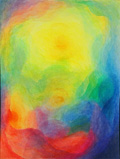 |
|
Colour experience |
From the new knowledge acquired concerning the “language of colour”, thanks to Steiner’s intuitions arise ample and original possibilities to obtain a catchy and vivid new ”language of colour in pictorial works”, as well as in the education, artistic therapy etc.
The particular sensations it is question of, are a matter of impressions that go beyond the more common ones of liking or disliking, of appreciation or the lack of it that all feel, when they come across colours. In this latter case, they have a completely individual character, which is therefore subjective and which arises with an immediate impact on the superior levels of the soul. Goethe instead refers to feelings felt in the deeper reaches of the soul. They have a totally objective character (therefore not individual) because they arise from the nature of the colours themselves. They are perceived intimately on contemplating colours, while allowing them to act freely on the soul, that is without immediately confronting them with individual sentiments or judgements, which usually arise with spontaneous immediacy.
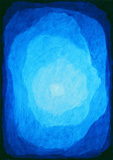 |
|
BLU radiates towards a central point |
This peculiarity offers great opportunities for realizing chromatic compositions that may arouse more intimate and new sensations in the observer, that is as above mentioned, a new, more touching pictorial language.
He – if he wishes to realize a Goethean painting – must above all follow careful practices to sharpen his sensibility in grasping the nature of the individual colours and their combinations. This is even more the case when the composition develops further with the addition of new colours.
THE DYNAMICS OF COLOUR
Rudolf Steiner and, following him, the famous painter Kandinsky too, drew attention to the experimentation of determined movements within the soul felt in the subconscious when contemplating colours. They are intimate feelings of concentration, expansion and relaxation comparable, on exterior levels, to the kinds of dynamism that are known as centripetal, centrifugal and static forces.
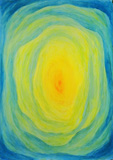 |
|
YELLOW radiates and expands itself; it cannot be closed by BLUE, but enlightens and converts it into GREEN, in alternative YELLOW climbs over and escapes
|
Blue, for example, is felt with a movement of the soul that tends to go towards a central point closing within itself (concentration), yellow as a movement of expansion towards the exterior, red as an element of equilibrium between two opposing dynamic forces, thus of relaxation. This is all in addition to the well-known perspective characteristics of colours, and thus of distancing, approaching, of aggression and calm.
Therefore if we take these elements into consideration:
objective impressions aroused by individual colours and the various ways they can be placed together;
internal movements of the soul
concentration, expansion and equilibrium;
distancing, approaching, aggression and calm;
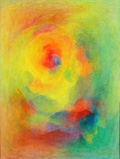 |
| Colour experience |
Steiner suggested the realization of a pictorial procedure in which colours, instead of being subordinated to the requirements of a drawing or to the expression of the artist’s personal emotions, should be employed and carried through so that what is normally felt in the subconscious can appear on the surface of the soul.
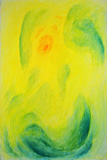 |
|
YELLOW radiates and expands itself; it cannot be closed by BLUE, but enlightens and converts it into GREEN, in alternative YELLOW climbs over and escapes
|
This means placing colours alongside each other, overlapping or moving them with the correct relations and dynamisms, as shown by both Goethe and Steiner, so that they can fully demonstrate their expressive force. This force usually remains “mortified” when colours are not left free to appear according to their own nature, but are subjected to a drawing or to express a particular individual emotion.
It was already emphasized that a fundamental condition for completing a painting that corresponds to the requirements described is to be found in the capacity of the artist to enter so fully into the colour as to live within it and consciously perceive its nature and requirements. Everyone has an attitude in developing this capacity, as long as it is exercised with devotion and intense work in experimenting individual colours and the various possible combinations, in the sense Goethe indicated.
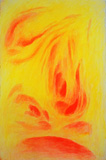 |
|
RED on YELLOW is felt like ORANGE; it becomes active while YELLOW warms up |
An artistic composition aimed at reaching the goals of Goethe would therefore start from a simple experiencing of colours in combination, overlapping, moving in space while at the same time calling for the contribution of other colours. All this takes place just by following the needs of their nature and situations that are developing bit by bit. This leads to a continuous succession of chromatic metamorphoses up to the composition achieving a complete meaning. Seeing that the artist has neither followed through his own project nor his individual emotions in producing it, but instead the natural requirements of the colours, he is able to arouse intimate and touching emotions.
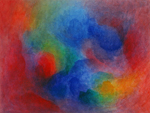 |
| Colour experience |
THE LIVING ESSENCE OF COLOUR
For a clear understanding of Goethean painting process one must bear in mind that the above objective sensations of colours are better experienced when they appear in their original essence, that is, as light
In fact, the Goethean and Steinerian conception holds that colours come into being as a particular and varied manifestation of light. What we see in things are in reality only aspects of colour-light, captured in matter and condensed in it.
The true essence of colours is therefore light we perceive in various quality-colours. Light, as a fluctuating essence in universal spaces, enters into situations or conditions which allow it to perform a greater or lesser irradiation up to the very limits of its own extension and thus to the appearance of darkness. All this is perceivable by the eye as phenomena of colour of different qualities, according to the circumstances.
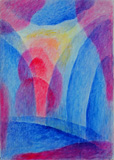 |
|
RED cannot be closed by BLUE; it resounds into the BLUE surface |
Just as unceasing and constantly changing interactions take place between light and darkness in universal space, equally continuous and changing appearances of different quality colours occur too. Forms and figures emerge from their interweaving. This led Steiner to declare: “Colours are the actions of light.”
Goethe gave wide-ranging examples in his “Theory of Colours” of the phenomena produced by the interaction of light and darkness.
When we contemplate the fluctuating activity of colours in light and immersing ourselves in them, our soul feels the lively sensations characteristic of their nature in its deepest reaches, as described by Goethe and Steiner. This experience for Steiner is both the basis and starting point in stimulating the creation of a pictorial work.
“GOETHEAN PAINTING” OR “ANTHROPOSOPHICAL PAINTING”
But with pictorial composition there is instead material available.
It is just here that the concealed movements of the soul described by Steiner take on a major, fundamental and ineluctable importance. In fact, if the artist takes account and arranges the colours reproducing externally those intimate movements of the soul (centrifugal, centripetal and relaxation) and follows them up and backs them up during the elaboration and following on to meeting-clash of opposing dynamic forces, then the observer will come to feel those touching, live and fascinating objective sensations, normally perceived before colour-light, even if at the moment the painting is still at the stage of the simple pigment, that is the material. If one omits doing this, those colours will appear only as simple coloured surfaces – perhaps even pretty and pleasant – but without life.
A different and new way of painting is born from this particular and original mode of working which, in recognition of the primary source it comes from, Balduino calls “Goethean painting”. Others, and there are more of them, prefer in general to define it as “Anthroposophical painting” or “Steinerian painting” in consideration of the conception expressed above of the effective essence of colours being traced back not only to Goethe, but also to the much greater Anthroposophical conception.
It must be clearly stated that the Goethean painting, we consider here, should not be confused with either the pedagogic Steinerian one or the therapeutic one, which have a common origin, but instead seeks different aims and types of execution. This is because the pictorial procedure described here has utterly artistic goals and so can be distinguished clearly from other forms of Steinerian painting, by its different and more complex methods as well.
From what had been said, it is clear that the intention of an artistic production realized according to the principles of Anthroposophical or Goethean painting therefore consists in creating pictures in which the colours and forms spring up and metamorphose following the natural requirements as in light-colour, so creating in the microcosm, that is, in the chromatic composition, a life analogous to the one fluctuating in the macrocosm.
THE CREATIVE ACTION OF THE COLOUR
A genuine Goethean or Anthroposophical painting can never be a copy or reproduction of some model or the expression of the artist’s feelings or thoughts, but only an original creation drawn from the formative forces of the colours in the composition, perceived by the artist and working in a way analogous to the light-colour fluctuating in the universe.
Goethean painting reaches its highest and truest aim when the complex of colours developed following, as noted above, their changing requirements, obtains an equilibrium and a full meaning and has come to life spontaneously, that is determined by the situations that were developing gestures and forms. We must be able to say that they were generated from colour.
Gestures and forms, as the most evident and conclusive elements of this chromatic world, express the quintessence of it. In the forms we shall find enclosed the hidden content of that particular world of colours.
The artist must interpret the meaning of them, elaborate them and make them clear. Thus he will gradually make the content of that world readable, unleashing the IDEA and the MOTIVE of the painting.
Each colour composition manifests its creative action of forms. It is an infinitesimal particle in a universe of colours that fluctuate in incessant activity. The forms themselves are not static, but continuously active, and thus express not a single, but several possible contents.
In each form, the artist, according to individual intuitive capacity, grasps one or other expression and stably and definitively imprints it on the painting, concluding it with an IDEA, a MOTIVE that has been CREATED FROM COLOUR.
FIGURATIVE PAINTING?
In art neither rules nor limits can be laid down. This notwithstanding the dilemma “figurative or non figurative painting” is steadily a current question. Those artists who intend to work following the Goethean or Anthroposophical principles, and who are fully conscious of the clear goals of this original artistic movement, have clear opinions on the argument,
A simple fully developed colour composition, even without the slightest suggestion of figuration, in which, following the principles given, the colour appears as living and touching, is capable of reaching the very depths of the soul of the observer. It wins over and seizes its life of feeling. It involves the sensitive part of the soul. In other words, according to the definition in Anthroposophy, it involves the “Sentien Soul.”
A figurative painting, which clearly represents intelligible contents, instead reaches the sphere of thought and thus the range of clear consciousness. If however the representation, the idea, is really released by a living and touching chromatic composition realized according to Goethean principles, then it penetrates the depths of the nucleus of the ego which involves the “Conscious Soul”, as it is called in Anthrposophy, and may come to awaken dormant forces of the “I” or the “Spirit Self”
A figurative painting is more complete in this perspective, even if a simple colour study, as long as it has life, is a work of art and can uplift the soul of the observer.
Nevertheless, it should be said that an Anthroposophical (or Goethean, if preferred) painting that really intends to carry out its tasks and reach its goals, cannot be separated from the elaboration of a colour composition that begins as abstract, but living, to later extract a representation, an idea, from its content
WATER COLOUR PAINTING
The material normally used in Goethean painting is watercolour because, thanks to their fluidity, colour remains very much alive and thus allows the producer to perceive the moral action almost as if taking place with colour-light. This is not all: but also because water colour is the only means that, due to its fluidity, allows for constant painting over and veiling, so conserving a fascinating transparency.
Clearly with this new painting procedure, the watercolour is not handled with the classical technique, but with new particular techniques that allow for it to be kept alive and transparent, despite reaching unusually great intensifications of tone.
It is just the chromatic intensity achieved and the fascination of transparencies obtained that reawaken deep and thrilling emotions in the observer.
|







